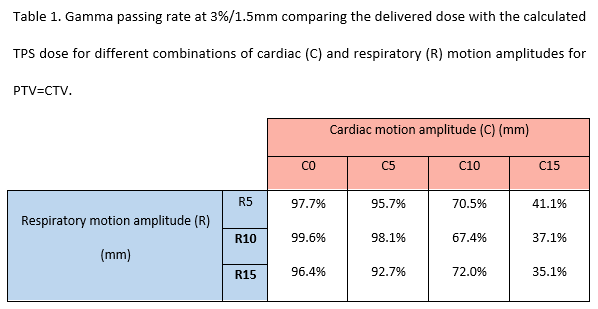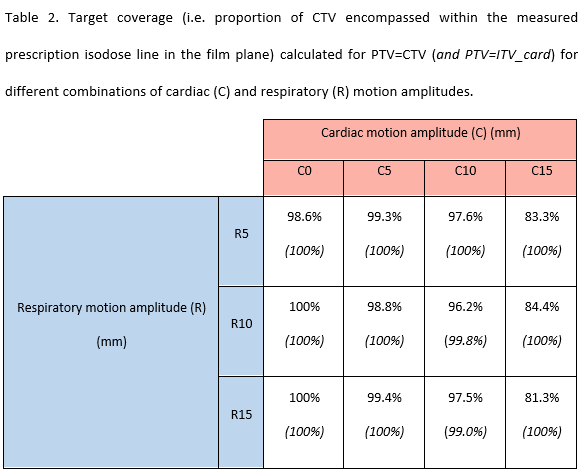Dosimetric impact of cardiac motions for CyberKnife stereotactic arrythmia radioablation
Renaud de Crevoisier,
France
PO-1897
Abstract
Dosimetric impact of cardiac motions for CyberKnife stereotactic arrythmia radioablation
Authors: Julien Bellec1, Lucien Lemaire2, Louis Rigal2, Raphaël Martins2, Renaud De Crevoisier3, Antoine Simon2
1Centre Eugene Marquis, Department of Medical Physics, RENNES, France; 2Univ Rennes, CHU Rennes, CLCC Eugene Marquis, Inserm, LTSI , UMR 1099, Rennes, France; 3Univ Rennes, CHU Rennes, CLCC Eugene Marquis, Inserm, LTSI , UMR1099, Rennes, France
Show Affiliations
Hide Affiliations
Purpose or Objective
To evaluate the ability of proactive beam delivery synchronization of CyberKnife in presence of cardiorespiratory motions.
Material and Methods
A Quasar respiratory motion phantom (ModusQA Inc) containing a homogeneous moving film cassette insert with a virtual CTV and 3 fiducial markers was placed on a Quasar respiratory motion platform (ModusQA Inc) for simulating different combinations of cardiac (Cx) and respiratory (Ry) motion amplitudes with x ranging from 0 to 15 mm and y ranging from 5 to 15 mm. Treatment plans were optimized in Precision v3.2 (Accuray Inc.) treatment planning system (TPS) and delivered on a CyberKnife M6 equipped with an Incise2 MLC (Accuray Inc.). For each cardiorespiratory combination, two PTV were designed: a PTV equal to the CTV (PTV=CTV) and a PTV encompassing the whole cardiac excursion of the CTV (PTV=ITV_card). All treatment plans were optimized to ensure an optimal conformality of the prescription isodose line to the PTV (new conformality index = 1.1), and were delivered using the Synchrony respiratory tracking system (Accuray Inc). Delivered dose distribution was measured with EBT-XD Gafchromic film (Ashland Inc) which was placed into the film cassette insert. For PTV=CTV, the measured dose was compared to the calculated TPS dose in the film plane by performing a gamma index analysis at 3%/1.5 mm criteria. Evaluation of target coverage (TC) which was defined as the proportion of CTV encompassed within the prescription isodose line level on the film plane were evaluated for both PTV=CTV and PTV=ITV_card. Additionally, the Synchrony model generated during treatment plan delivery was compared to the effective motion of the CTV.
Results
Gamma passing rate and TC are reported in Table 1 and Table 2, respectively. When using PTV=CTV, the mean gamma pass rate over the evaluated respiratory motion amplitudes was 97.9%, 95.5%, 69.9% and 37.7% for C0, C5, C10 and C15 respectively; and mean TC over the evaluated respiratory motion amplitudes was 99.5%, 99.2%, 97.1% and 83.0% for C0, C5, C10 and C15 respectively. When using PTV=ITV_card, TC was systematically higher than 99% in any combinations. For all cardiorespiratory motions, the CTV motion modelled by the Synchrony tracking system during beams delivery was consistent with only the respiratory component of CTV motion.


Conclusion
In presence of cardiorespiratory motions, the CyberKnife is not able to synchronize the beam delivery with the actual target motion: only the respiratory motion component is trackable with the Synchrony tracking system. Cardiac motions induce a dose blurring effect which degrade the consistency between delivered and calculated dose and reduce target coverage. Nevertheless, the target coverage keeps clinically acceptable for cardiac motions not exceeding 10 mm. The implementation of an ITV-based strategy for cardiac motion management coupled with an active respiratory motion management warrants an optimal target coverage.